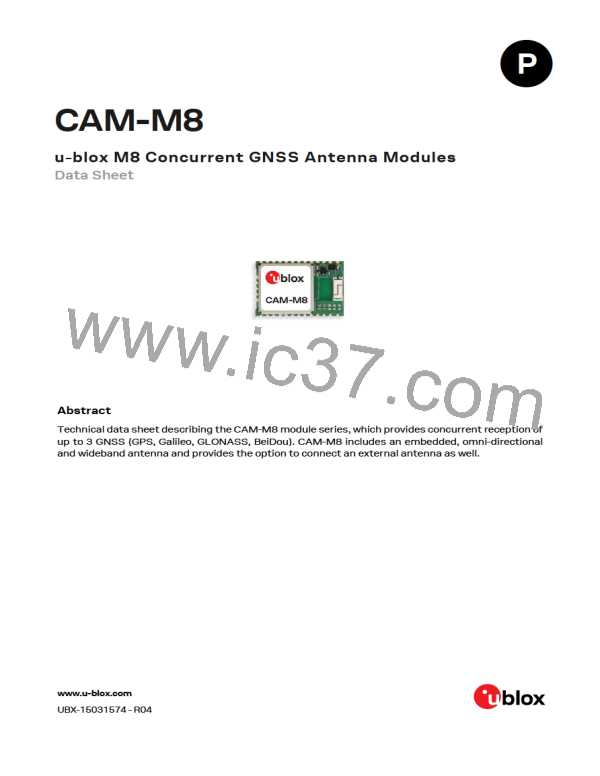CAM-M8 - Data Sheet
1.5 Supported GNSS constellations
The CAM-M8 series GNSS modules are concurrent GNSS receivers which can receive and track
multiple GNSS systems: GPS, Galileo, GLONASS and BeiDou. Owing to the dual-frequency RF front-
end architecture, either GLONASS or BeiDou can be processed concurrently with GPS and Galileo
signals providing reception of three GNSS systems. By default the M8 receivers are configured for
concurrent GPS and GLONASS, including SBAS and QZSS reception. If power consumption is a key
factor, then the receiver should be configured for a single GNSS operation using GPS, Galileo,
GLONASS or BeiDou and disabling QZSS and SBAS. The module can be configured to receive any
single GNSS constellation or within the set of permissible combinations shown below.
GPS
Galileo
GLONASS
BeiDou
•
•
•
•
•
–
–
–
•
•
•
–
–
•
•
–
–
•
–
•
–
•
–
•
–
–
•
–
•
–
•
•
Table 2: Permissible GNSS combinations (• = enabled)
☞
☞
The augmentation systems: SBAS and QZSS can be enabled only if GPS operation is configured.
Galileo is not enabled as the default configuration.
1.5.1 GPS
The u-blox CAM-M8 series positioning modules are designed to receive and track the L1C/A signals
provided at 1575.42 MHz by the Global Positioning System (GPS).
1.5.2 GLONASS
The CAM-M8 modules can receive and process GLONASS concurrently with GPS or BeiDou. The
Russian GLONASS satellite system is an alternative system to the US-based Global Positioning
System (GPS). u-blox CAM-M8 positioning modules are designed to receive and track the L1OF
signals GLONASS provided at 1602 MHz + k*562.5 kHz, where k is the satellite’s frequency channel
number (k = –7,..., 5, 6). The ability to receive and track GLONASS L1OF satellite signals allows design
of GLONASS receivers where required by regulations.
In order to take advantage of GPS and GLONASS, dedicated hardware preparation must be taken
during the design-in phase, see the CAM-M8 Hardware Integration Manual [1] for u-blox design
recommendations.
1.5.3 BeiDou
The CAM-M8 series positioning modules can receive and process the B1I signals broadcast at
1561.098 MHz from the BeiDou Navigation Satellite System. The ability to receive and track BeiDou
signals in conjunction with another constellation results in higher coverage, improved reliability and
better accuracy. Currently, BeiDou is not fully operational globally and provides Chinese regional
coverage only. Global coverage is scheduled for 2020.
UBX-15031574 - R04
Production Information
Page 8 of 31

 U-BLOX [ u-blox AG ]
U-BLOX [ u-blox AG ]